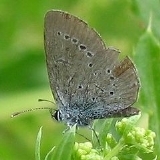
Small Blue
Encyclopedia
The Small Blue is a butterfly
in the family Lycaenidae
.
It is found in Europe
, Asia Minor
, Transcaucasia, Tian-Shan, West Siberia
, Central Siberia, South Siberia, Russian Far East
, Amur
, Mongolia
, Magadan
and Kamchatka.
Recorded larval foodplants are Oxytropis campestris
, Astragalus alpinus
, Lotus corniculatus
, Anthyllis vulneraria
,Melilotus, Coronilla
, Medicago
, Anthyllis vulneraria
, Astragalus glycyphyllos
and Astragalus cicer
Butterfly
A butterfly is a mainly day-flying insect of the order Lepidoptera, which includes the butterflies and moths. Like other holometabolous insects, the butterfly's life cycle consists of four parts: egg, larva, pupa and adult. Most species are diurnal. Butterflies have large, often brightly coloured...
in the family Lycaenidae
Lycaenidae
The Lycaenidae are the second-largest family of butterflies, with about 6000 species worldwide, whose members are also called gossamer-winged butterflies...
.
It is found in Europe
Europe
Europe is, by convention, one of the world's seven continents. Comprising the westernmost peninsula of Eurasia, Europe is generally 'divided' from Asia to its east by the watershed divides of the Ural and Caucasus Mountains, the Ural River, the Caspian and Black Seas, and the waterways connecting...
, Asia Minor
Asia Minor
Asia Minor is a geographical location at the westernmost protrusion of Asia, also called Anatolia, and corresponds to the western two thirds of the Asian part of Turkey...
, Transcaucasia, Tian-Shan, West Siberia
Siberia
Siberia is an extensive region constituting almost all of Northern Asia. Comprising the central and eastern portion of the Russian Federation, it was part of the Soviet Union from its beginning, as its predecessor states, the Tsardom of Russia and the Russian Empire, conquered it during the 16th...
, Central Siberia, South Siberia, Russian Far East
Russian Far East
Russian Far East is a term that refers to the Russian part of the Far East, i.e., extreme east parts of Russia, between Lake Baikal in Eastern Siberia and the Pacific Ocean...
, Amur
Amur
The Amur or Heilong Jiang is the world's tenth longest river, forming the border between the Russian Far East and Northeastern China .-Course:...
, Mongolia
Mongolia
Mongolia is a landlocked country in East and Central Asia. It is bordered by Russia to the north and China to the south, east and west. Although Mongolia does not share a border with Kazakhstan, its western-most point is only from Kazakhstan's eastern tip. Ulan Bator, the capital and largest...
, Magadan
Magadan
Magadan is a port town on the Sea of Okhotsk and gateway to the Kolyma region. It is the administrative center of Magadan Oblast , in the Russian Far East. Founded in 1929 on the site of an earlier settlement from the 1920s, it was granted the status of town in 1939...
and Kamchatka.
Recorded larval foodplants are Oxytropis campestris
Oxytropis campestris
Oxytropis campestris is a plant native to the Northwestern United States and all Canada, sometimes grown as an ornamental plant.It is found in prairies, woods, and meadows, and prefers gravelly and rocky slopes, where it grows most abundantly. The plant has numerous...
, Astragalus alpinus
Astragalus alpinus
Astragalus alpinus is a species of flowering plant in the legume family known by the common name alpine milkvetch. It has a circumpolar distribution, occurring throughout the upper latitudes of the Northern Hemisphere. It is widespread in Eurasia...
, Lotus corniculatus
Lotus corniculatus
Lotus corniculatus is a common flowering plant native to grassland temperate Eurasia and North Africa. The common name is Bird's-foot Trefoil , though the common name is often also applied to other members of the genus...
, Anthyllis vulneraria
Anthyllis vulneraria
Anthyllis vulneraria is a medicinal plant native to Europe. The name vulneraria means "wound healer".-Description:...
,Melilotus, Coronilla
Coronilla
The genus Coronilla contains Old World shrubs and herbs.Coronilla species are used as food plants by the larvae of some Lepidoptera species including the case-bearers Coleophora coronillae and Coleophora vicinella.Species include:* Coronilla glauca* Coronilla iberica* Coronilla minima* Coronilla...
, Medicago
Medicago
Medicago is a genus of flowering plants, commonly known as medick or burclover. The name is based on Latin medica 'alfalfa, lucerne,' from 'Median .'...
, Anthyllis vulneraria
Anthyllis vulneraria
Anthyllis vulneraria is a medicinal plant native to Europe. The name vulneraria means "wound healer".-Description:...
, Astragalus glycyphyllos
Astragalus glycyphyllos
Astragalus glycyphyllos is a flowering plant in the family Fabaceae, native to Europe. It is a perennial herbaceous plant which sometimes used for tea.-External links:**...
and Astragalus cicer
Astragalus cicer
Native to Eastern Europe, the cicer milkvetch, Astragalus cicer – popularized and subsequently transported to areas in Southern Europe, North America, and South America – is a perennial angiosperm , or a plant that commonly lives for two or more years. Cicer milkvetch exhibits legume-like...

